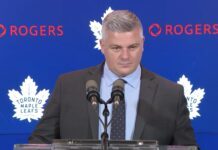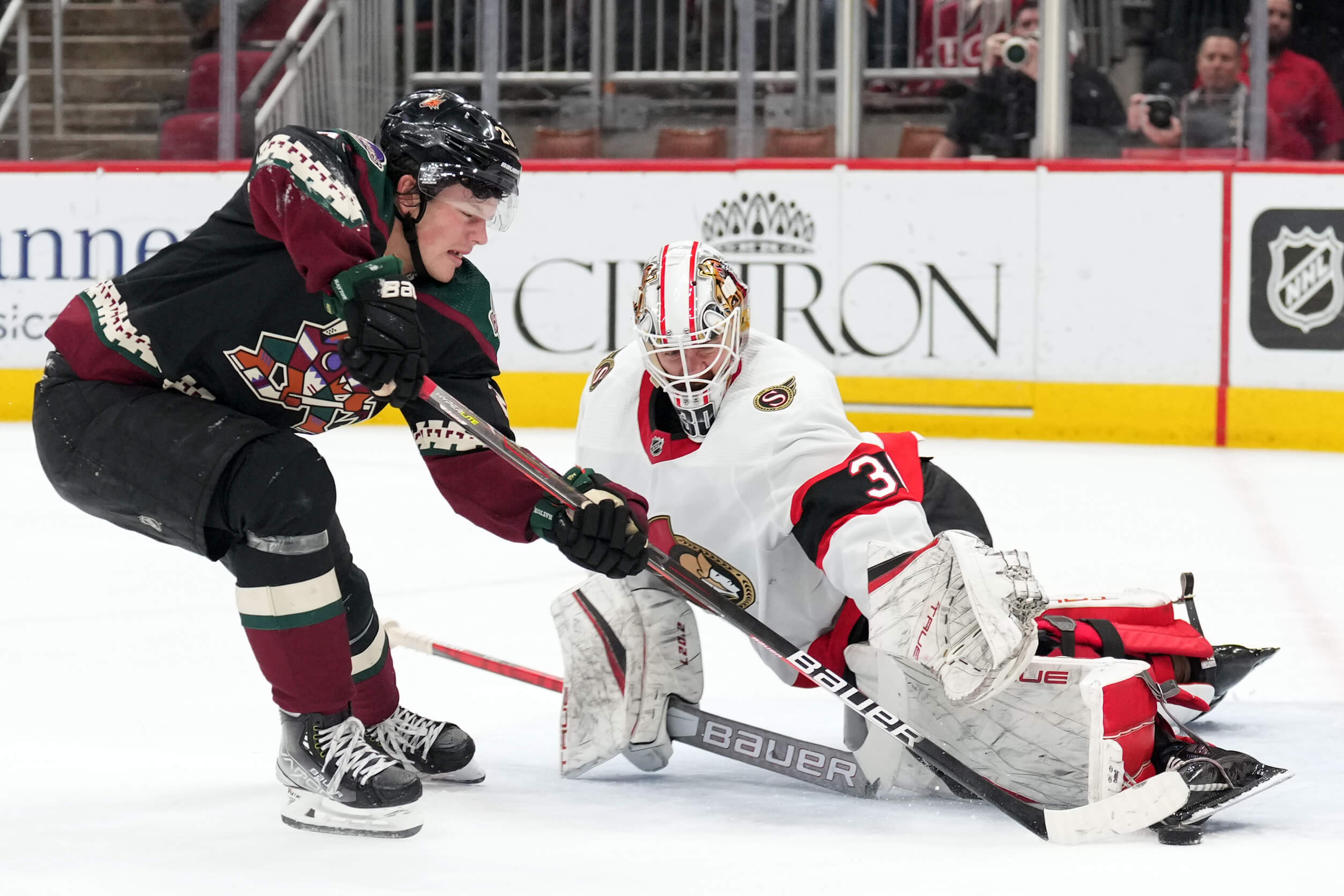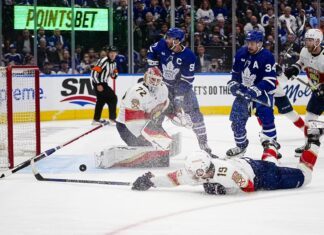The Toronto Maple Leafs acquired goaltender Matt Murray (with 25% salary retained) from the Ottawa Senators on Monday night along with future third and seventh-round picks in exchange for future considerations.
The Maple Leafs have landed on one of their two goalies for the 2022-23 season in Murray, a two-time Stanley Cup champion whose career has taken several twists and turns over the past five years. The speculation had been rumbling for several days before Kyle Dubas and Pierre Dorion finally closed the deal.
In this piece, I will look at Murray’s history as an NHL goalie before sharing some quick-reaction takes that will analyze the transaction from a multitude of angles.
Matt Murray, NHL goaltender
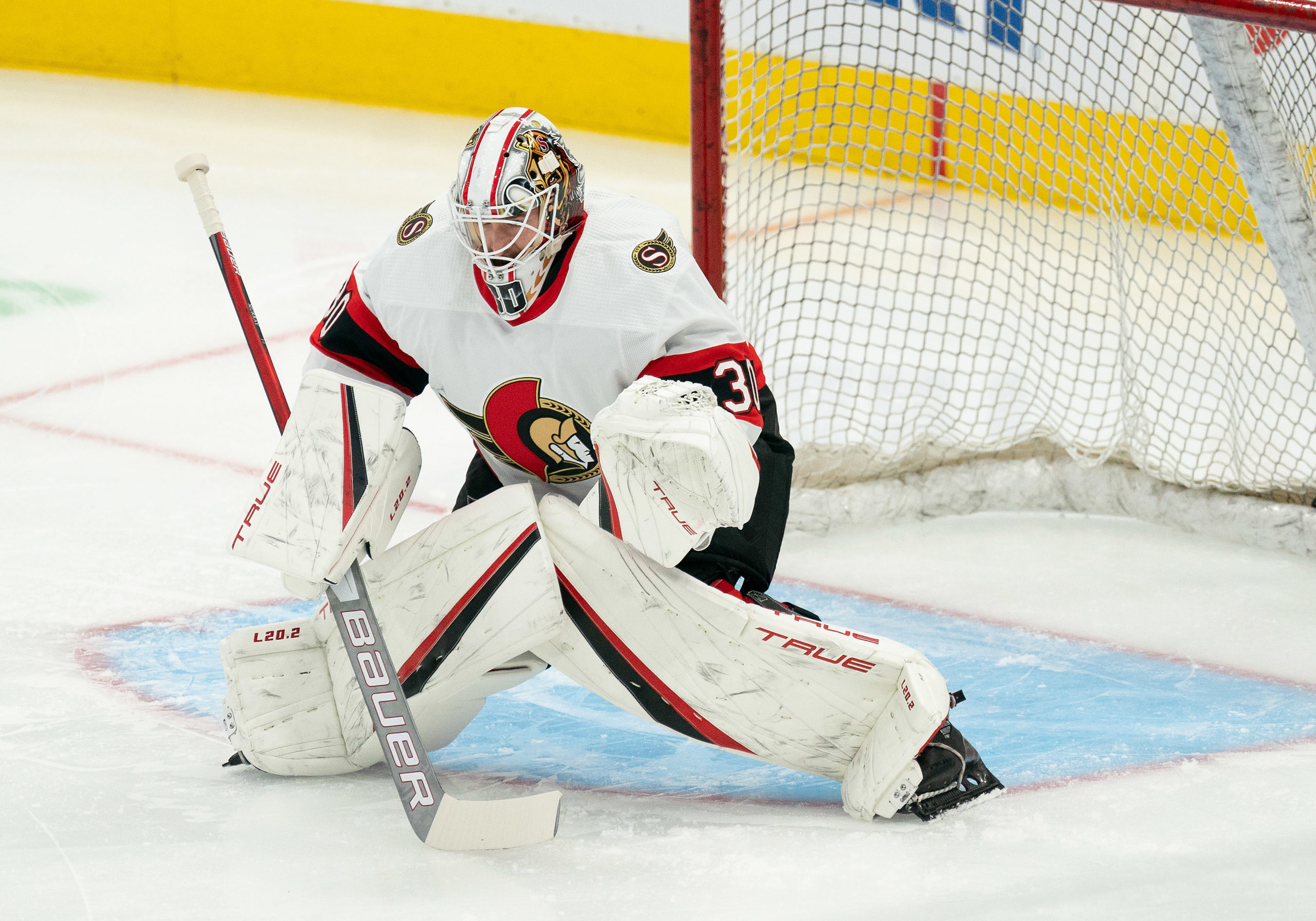
Our own Kevin Papetti wrote about this in full yesterday, and I would recommend reading that piece for more information, but I will summarize elements of it. Murray is a native of Thunder Bay who was picked in the third round of the 2012 NHL Entry Draft by the Pittsburgh Penguins. He played his junior career with (surprise!) the Soo Greyhounds of the OHL, where he was rather subpar through his first three seasons before erupting to the tune of a .921 SV% in 2013-14. He was named to the OHL All-Star Second Team at the season’s conclusion and then jumped up to the AHL.
Murray spent 1.5 seasons in the AHL with Scranton Wilkes-Barre, where he was terrific, with a .941 and a .931 SV% during the 2014-15 and 2015-16 seasons, respectively. For his 2014-15 campaign, Murray was named AHL Rookie of the Year and Goaltender of the Year, and these achievements quickly put young Murray on-track to be the successor to Marc-Andre Fleury in Pittsburgh.
Murray got his shot at the tail-end of the 2015-16 season when Fleury sustained a concussion that would keep him out for weeks. Murray posted a .930 SV% in 13 regular-season games and then took over the reins in the playoffs, where he outdueled Braden Holtby in round two against the Caps. Despite Fleury’s return in Game 4 of the Eastern Conference Finals, Murray wrested control of the crease back in time to allow just one goal in a Game 7 victory over Tampa Bay. Murray stopped 127 of 138 shots (.920) in the 2016 Stanley Cup Final, backstopping the Penguins to a championship over San Jose.
Murray followed up his rousing 2016 campaign with a terrific 2016-17, including a .923 SV% and a +16.99 GSAx over 49 games in the regular season, to earn a nod on the All-Rookie Team. Unfortunately, an injury caused Murray to miss the first two rounds of the playoffs, where Fleury took the crease back over until Murray was able to return in the middle of the Eastern Conference Finals against Ottawa.
The Penguins trailed in the series at the time, but Murray’s return supercharged them. He won three of the four he started, including the dramatic 2OT victory in Game 7; Murray’s .946 SV% performance was a big deciding factor. Murray was strong in the Stanley Cup Final against Nashville with a .931 SV%, and his shutout in Game 6 locked the series down for Pittsburgh, who secured their second straight Cup win.
The 2017-18 season included the death of his father in the middle of it and represented a small fall back to earth overall (.907 SV%, -7.6 GSAx), but 2018-19 was nothing to scoff at (.919 SV%, -0.08 GSAx). The Penguins came up short in the playoffs both years, but taken in totality, four seasons into Matt Murray’s NHL career, he was an above-average NHL starter. He had a career .917 SV% and 12.36 goals saved above expected in the regular season while averaging close to 50 starts a year — not to mention a career .922 SV% and 7.67 goals saved above expected in the playoffs (with two Stanley Cup rings as a starter).
Murray’s career began to derail in 2019-20. He was poor in the regular season (.899 SV% and -13.98 GSAx) and saw his job heavily contested by Tristan Jarry. Murray still got the start in the bubble qualifying round against Montreal, and while he was not bad in the series, he was out-dueled by Carey Price and benched in favor of Jarry for the deciding game.
That was the end of Murray in Pittsburgh. He was dealt to Ottawa before the 2020-21 season began and inked a large contract extension. The first season with the Senators was no better; he suffered through a brutal, injury-riddled campaign ending in a ghastly .893 SV% and -15.22 GSAx in just 27 games(!). He suffered an injury in every full month of the shortened season, and Senators management began to lose confidence in him.
This past season was a small bit of redemption for Murray, but the injury issues didn’t go away. He dealt with injuries out of the gate — as well as COVID-19 — but once finally healthy, Murray put together a renaissance stretch in January and February that saw him catch fire to the tune of a .941 SV% over 11 starts.
Unfortunately, Murray’s final two games were very rough, and he suffered another injury that ended his season in early March. The bad final two games docked the overall season numbers, but he still finished with a positive GSAx for the regular season for the first time since 2016-17.
Quick Reactions
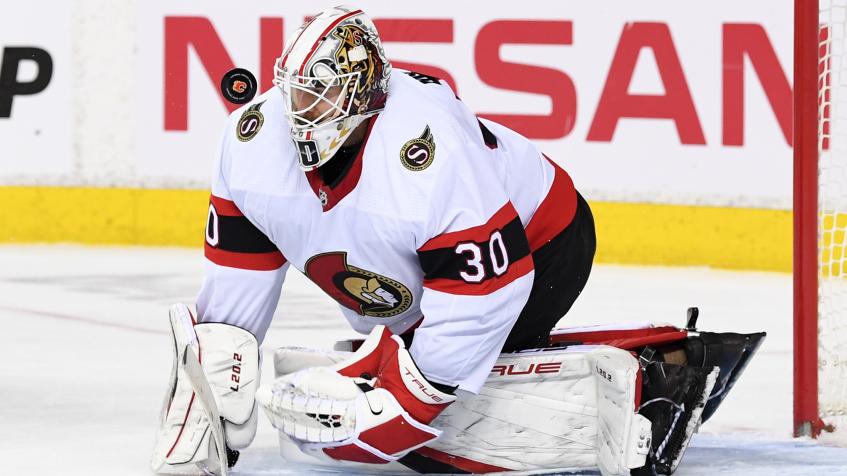
1. At first glance, this is a gamble for the ages by Kyle Dubas & Co. In the days preceding the trade, many Leafs fans had been priming themselves for a transaction involving Matt Murray, and I felt that Kevin did a very good job of presenting the positive angle. Murray has indeed had glimmers of hope amid a rough few seasons; last season was strong (when healthy), and Elliotte Friedman reported on 32 Thoughts today that Murray made some tweaks to his game structurally (moving side to side) that are supposed to improve his overall form.
I can see why Matt Murray coming to Toronto may indeed bring out better results than Matt Murray accomplished in Ottawa. Battles with coach DJ Smith and the Senators’ management team (including over a minor-league assignment at one point) may have damaged Murray’s confidence, and the situation in Toronto is pretty much the exact opposite. Murray will be joining a Leafs organization that he is incredibly familiar with — notably Kyle Dubas, Sheldon Keefe, and Jon Elkin. Being surrounded by people who you are familiar with and who believe in you, in addition to getting the chance to be the starting goalie for a Stanley Cup contender, are all things that should restore some of the mental components of Murray’s game that have been missing. Likewise, the Leafs have a stellar medical staff, which could help keep Murray healthier than he has been in Ottawa.
That was enough of a case to make me believe a deal made sense for Toronto if Murray’s salary was at least 50% retained (a third team could’ve been involved to eat even more), and/or the sweetener in the trade was enticing. This deal checks neither of these boxes.
The sweetener (two distant mid-to-late-round picks) is not useful in the immediate term, and only 25% of the cap hit is retained. By paying Matt Murray $4.688M against the cap this upcoming season and receiving nothing meaningful along with it, Kyle Dubas is acting like he believes Matt Murray is a good bet to be a quality starter for a Stanley Cup contender in 2022-23. That, to me, is the biggest takeaway of the deal.
And boy is that a hell of a gamble. Matt Murray has been a good enough goalie to win Stanley Cups in the past. That much we know. Unfortunately, that “past” is a while ago, and the recent history includes a ton of warning signs. Murray was the sixth-worst goalie in the NHL (by GSAx) in Evolving Hockey’s data in 2019-20 and then was the fifth-worst goalie in 2020-21. This past year, his play perked up, but unlike those previous two years, he was not a starter and played just 20 games in total.
In assuming a $4.688M cap hit for Murray, the Leafs are paying him starting goalie money — only a smidge below such goalies as Thatcher Demko, Robin Lehner, and Juuse Saros, as well as what Jack Campbell is rumored to be in line for this week in free agency. When you pay a goalie that amount, you’re signaling that A) you expect them to be the starter (play 40-50 games) and B) you expect them to be good at goaltending. Matt Murray has not been both good and a starter since 2018-19.
That’s the massive gamble part of this. Leafs management is asking him to do something that probabilistically does not feel super likely at this point in time. There’s a chance that Murray is good next year. There’s a chance Murray is healthy next year. The chance he’s both good and healthy, though? Based on the track record, I cannot say it is probable right now.
2. Either Kyle Dubas has total, unbreakable faith in Matt Murray, or he does not feel his job is on the line. What I think is most interesting about this deal is how it looks from Dubas’ vantage point. Leafs fans on social media who are okay with the deal generally went with the line, “Well, I’d rather give Murray 2 x $4.688M than Campbell 5 x $5M.” The implication here is that the latter is a long-term deal that may age very poorly for a goalie in his 30s like Campbell.
That would be one of the only rationales for this move. What is unique is that the rationale, “Don’t give out a long-term deal that may age poorly,” is not typically a consideration for most NHL GMs, who operate in short-term windows in which their main concern is saving their own jobs. Typically, a GM in Kyle Dubas’ position, with a win-now team and an ostensibly warm seat beneath him, would throw five or six years at Jack Campbell or Darcy Kuemper and say, “It’ll probably be terrible in 2027, but we need to win in 2023 or else my job is gone, so it makes sense now. When it’s bad, it’ll probably be someone else’s problem.”
Instead, Dubas is not doing that, which leads me to believe either A) Dubas thinks Murray is a better goalie for 2022-23 than either Campbell or Kuemper or B) Dubas is planning to still be the GM in 2027, which is long-term thinking that would be extremely unusual for a GM of a team that has not achieved anything of value in the playoffs under his watch.
If it’s scenario A, then Dubas is making a hell of a gamble on Matt Murray and coming to a conclusion that I, personally, have not come to. If it’s scenario B, then I wonder if Dubas has been assured much longer-term job security from MLSE than anyone could imagine. If he had been told that 2022-23 is make-it-or-break-it with his job on the line and then Dubas elected Murray as the goalie to roll with for such a season, it’s a leap of faith akin to Indiana Jones stepping off the cliff in The Last Crusade.
A fascinating deal from so many angles.
3. The Leafs need to figure out who their other goalie is going to be. After the trade broke, we were given this bit of news from Pierre LeBrun:
Leafs will keep looking for another goalie option as well. Someone with a reasonable price tag.
— Pierre LeBrun (@PierreVLeBrun) July 12, 2022
This obviously makes sense. Matt Murray is not the kind of goalie where, right now, you can roll into a season with him as the starter and Erik Källgren as the backup. Källgren did his best in a tough situation last season, but a .888 SV% and saving ~0.5 goals below expected each appearance is not good enough for an NHL backup. It’s possible Källgren could take another leap forward at some point next season, but the one who appeared in 14 games for Toronto in 2021-22 was not ready to be a 25-30 game NHL reserve goaltender.
The problem with the LeBrun tweet is the term “reasonable price tag.” Anyone who has followed the goalie market recently knows that there are not many reasonable price tags out there right now. Alexandar Georgiev, who has been a career 1B and has a .901 SV% over the past two seasons, inked a deal with Colorado this weekend with a $3.4M cap hit. Ville Husso, who has 64 total NHL appearances and got thoroughly routed in the playoffs by Minnesota, signed with Detroit last week on a contract that will pay him a $4.75M cap hit. The goalie market is crazy expensive right now, and so I’m not sure where the Leafs envision their goalie with a reasonable price tag will come from.
Old Friend James Reimer has a $2.25M cap hit in San Jose, but there haven’t been many indications that the Sharks are interested in moving him. The acquisition cost may be high. Instead, San Jose could move Adin Hill’s $2.175M cap hit, although he has not flashed a ton at the NHL level.
Remaining on the UFA market are Eric Comrie and Ilya Samsonov, who could be options. Comrie is a massive wild-card with only 28 career NHL games, but 19 of them last year in Winnipeg were spectacular. Is that a guy Dubas feels is ready to play 30 or so games for Toronto this year? If so, what would his cap hit be?
Samsonov is a former blue-chip prospect who torched the KHL but has struggled in both the AHL and the NHL, although the talent is obviously there. He was non-tendered by Washington today with the report being that the Caps felt that Samsonov’s cap hit (after arbitration) would fall in the $3M range.
This is where not getting the Senators (or a third team) to retain more of Murray’s deal really hurts. If more of Murray’s contract would have been retained, the Leafs could feel comfortable going after a second goalie and still feel like they have money to spend on filling out the forward depth chart. Instead, after they sign a second goalie, they will likely have very little money to address the forward position and add scoring depth.
It’s important to remember Murray’s injury history in the context of the hunt for a second netminder. There is a very real scenario where Murray falls injured again and the backups may be needed for 50+ games. It’s a nightmare scenario, but it’s the very scenario that just unfolded in Ottawa this past season. The Leafs need to acquire a goalie who is capable of playing that many games if worse comes to worst. In other words, it can’t be an Erik Källgren-level player.
4. Before you throw your remote through the television, this is goaltending. We probably don’t know anything. This time last season, your author felt that Frederik Andersen was completely cooked as an NHL starter and was stunned that Carolina paid him the contract they did. In 2021-22, Andersen proceeded to right the ship, stay healthy (in the regular season), and post some of the best numbers of any goalie in the NHL this past season.
Goaltending is extremely random and variable, and SV% from the past few seasons has very little correlation with SV% in the upcoming season:
*taps the sign*
From '18-21, there were 36 goalies that faced 2400 or more shots. Robin Lehner led these 36 goalies with a 92.3% Sv% all situations. Jonathan Quick was dead last, at 89.6%.
Quick had a better Sv% than Lehner in '21-22. https://t.co/yMSxIB1zFB
— Cam Charron (@camcharronyvr) July 11, 2022
It is totally possible that Matt Murray stays healthy, starts 50 games, puts up a .920 SV% and +5 GSAx, and the Toronto Maple Leafs roll into the Stanley Cup playoffs with a starting netminder who has the confidence of two Stanley Cup rings (something they’ve never had with this core) and the numbers to back it up — and he’d be doing it on a cap hit lower than what Jack Campbell will likely be signed for by Wednesday. That scenario feels not terribly likely, but it’s very much within the realm of possible outcomes. Murray has played that well before. He could easily do it again.
The problem: It feels like that scenario has to happen for this to be a good trade. There’s a middle scenario where Murray is alright, but there is also an equally likely universe where Murray has another year like he had in Ottawa in 2020-21 — habitually injured and subpar when he plays. If that happens and the Maple Leafs’ season goes down in flames because of it, we will look back on this deal as the kind of trade that got Kyle Dubas fired as GM. That’s the massive risk here.
Of course, goaltending is always a risk. The Oilers are likely to give Campbell a big deal and the Capitals to Kuemper; in both cases, those two goalies could respond by laying an egg in year one and delivering nothing for their mighty cap hits. Predicting goaltending is a fruitless endeavor unless you’re an oracle.
I don’t like this trade from the Leafs’ perspective right now, but the final summary of whether it is good or bad will not be known for sometime. Until then, let’s see what Matt Murray can do in Toronto.




